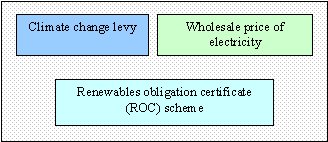


| Economics |
Costs per installed unit Value of marine current power Funding Future possibilities References
Costs per installed unit
In terms of approximate new plant costs per installed unit of power (2004), tidal energy is currently one of the most expensive due to the fact that it is an emerging technology. The approximate new plant costs per installed unit power are listed below.
| Gas Turbine | £500/kW |
| Onshore Wind | £605 - £800/kW |
| Offshore Wind | £1100 - £1430/kW |
| Marine | £1500 - £1800/kW |
| Wave | £2000/kW + |
| Energy crops | £1350 - £1620/kW |
As such, financial incentives are necessary to encourage the development of marine current power.
back to top
Value of marine current power
The value of tidal power is determined by three factors:

Under the Renewables Obligation, electricity suppliers must provide 10 per cent of their supply from renewable sources by 2010 (and 15% by 2015) or pay a fixed penalty per unit. However, tidal stream is at a competitive disadvantage. At present the price of electricity produced by wave and tidal stream technologies comes in at above 5p per unit. For commercial electricity suppliers, there are cheaper renewable alternatives. Additionally, tidal stream energy is not included in the Renewable Obligation list of acceptable technologies.
back to top
Funding
In terms of funding, there are additional barriers. There appears to have been a lack of coherence in the approach to research, with what funding there is being focused mainly on research work and less on the production of actual prototypes.
In historical terms, marine currents have been considered under the wave energy umbrella. Original funding for wave energy was initially only from Government. There was the Wave Energy Programme run from 1974. This was closed down in 1983 after spend of £17,000,000. Work continued after this date on small scale schemes, such as the shoreline OWC deployed in Islay of the early 90s. In the mid 90s, work was reinitiated by Wavegen and Ocean Power Delivery (the first major marine current project). These were mostly funded from commercial or private sources until recently. As a result of a decision to re-open the wave energy programme in 1999, with spending plans of £1,000,000 per annum on wave energy, both companies received government grants. Wavegen secured £1,500,000 from this source.
Currently there is a certain amount of funding available from the DTI's New and Renewable Energy Programme (mainly industry based projects), EPSRC Renewable and New Energy Technologies (RNET) (mostly university-led projects) and the Carbon Trust.
Recent government funding following from an earlier allocation of a total of £3.7m for new marine technology developments, pledged £9m of new funding packages from both the Government and the private sector support involving:
- £2 million in Government funding to build a Marine Energy Test Centre in Orkney and
develop two tidal stream energy projects, ‘Stingray’ and ‘Seaflow’.
The Marine Energy Test Centre, due to open this year, will provide the basic infrastructure for a developer to attach their device (including sea cabling, grid connection and onshore lab facilities etc). It assists developers by helping them to avoid paying these costs (usually 25% of development scheme).
- £2 million to promote research and development in existing and new tidal and wave power
technologies.
- Setting up of a new capital grants scheme to support wave and tidal projects,
worth at least £5million.
back to top
Future possibilities
Future possibilities for funding of tidal energy include the following:
- "Grading" of the Renewables Obligation to give emerging technologies an even playing field
to compete with more established such as wind.
- Secured investment through government-based guarantees of return on investment such as those
available in Portugual.
- Wholesale price rise – future issues with security of supply may result in an increase in the price of electricity, encouraging investment in a ‘homegrown’ renewable energy industry.
- EU Emissions Trading Scheme (2005) – this will push energy companies to invest in renewables
as discussed previously.
- Money raised legislatively – the Scottish people would pay for investment in tidal technology through increased taxes, but would see the benefit of this in socio-economic terms e.g. new industry and jobs.
References
- Richard Boud, Future Energy Solutions for the International Energy Agency and DTI (2003),
Status and Research and Development Priorities 2003 – Wave and Marine Current Energy,
International Energy Agency.
- DTI (Nov 2002), Future Offshore – A Strategic Framework for the Offshore Wind Industry,
HMSO.
-
Royal Society of Edinburgh (16 February 2001),
APPENDIX 27 Memorandum submitted to the Select Committee on Science and Technology Appendices (Minutes of Evidence)
HMSO
http://www.parliament.the-stationery-office.co.uk/pa/cm200001/cmselect/cmsctech/291/291ap29.htm -
Network for Alternative Technology and Technology Assessment (July 2003), £19m more for wave and tidal, Renew On Line 44,
Renew, issue 144 July- Aug 2003, The Open University.
http://eeru.open.ac.uk/natta/renewonline/rol44/4.htm -
Dave Elliott, SERA Energy Group (Summer 2002), Offshore gets On-message, New Ground 63.
http://www.serauk.org.uk/ng63_03.htm -
Speech Given By UK Energy Minister Brian Wilson (21 March 2003), Renewables Conference, Stornoway.
http://www.w-isles.gov.uk/energy/press34.htm
-
Oxcera (Feb 2004), Results of Renewables Market Modelling, Oxford, DTI.
http://www.dti.gov.uk/energy/renewables/policy/oxeraresults.pdf